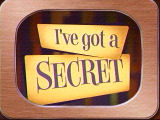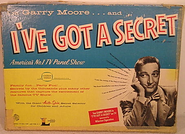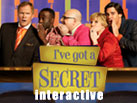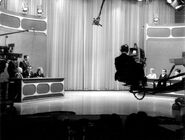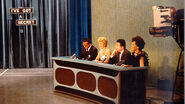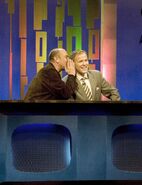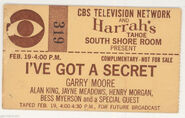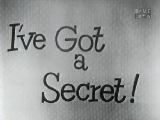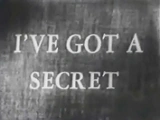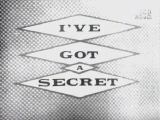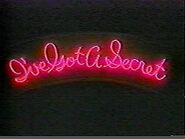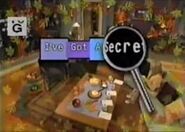| Hosts | |
|
Garry Moore (1952–1964) | |
| Sub-Hosts | |
|
Dennis O'Keefe | |
| Announcers | |
| John Cannon (1952–1967) Bern Bennett (sub) Johnny Olson (1972–1973, 1976) | |
| Broadcast | |
| CBS Primetime: 6/19/1952 – 4/3/1967Syndication (Daily): 9/11/1972 – 9/7/1973CBS Primetime: 6/15/1976 – 7/6/1976Oxygen: 2000–2001GSN: 4/17/2006 – 6/9/2006 | |
| Packagers | |
| Mark Goodson/Bill Todman Productions (1952–1976) Mark Goodson Productions/ FremantleMedia North America/ Paramount Television (2000–2001) Burt Dubrow Productions/ Get Real Entertainment (2006) | |
I've Got a Secret was a classic panel show where contestants have a hidden secret (hence the title) which is usually a stunt or occupation.
Regular Panelists
Bill Cullen
Faye Emerson
Jayne Meadows
Betsy Palmer
Bess Myerson
Richard Dawson
Henry Morgan
Pat Collins
Elaine Joyce
Jim J. Bullock
Jason Kravits
Amy Yasbeck
Teri Garr
Billy Bean
Frank DeCaro
Jermaine Taylor
Suzanne Westenhoefer
Gameplay
A panel of four celebrity guests faced one contestant or a group of contestants. Each contestant that appeared had a weird, fabulous, laughable and/or unusual secret. When the game started after the contestant came out & introduced himself/herself, the contestant whispered the secret into the host's ear, and the home audience was shown the secret. After that, the host would give a clue to the panel concerning the secret; that's when the questioning began. Each panelist one at a time in turn asked yes or no questions to the contestant in an attempt to guess the secret. The panelist in control would have an unmentioned amount of time to question the contestant. When the time was called by the producers and the panelist in control did not guess the secret, the next panelist in line would do the questioning. The process went on until either the secret was guessed, or until the entire panel questioned the contestant. After the game, the contestant would talk about his/her secret via the host's interview and sometimes a video/movie clip or demonstration would be shown.
Also on I've Got a Secret, celebrity guests played the game themselves. At the start of each show, the celebrity guest in question would introduce himself/herself followed by saying, "...and I've Got a Secret." The game was pretty much the same as with the regular contestants, but sometimes the panel would be off-stage in preparation of the game. Sometimes the secrets would be a personal secret, or something they were going to do that day.
Payoffs
On some versions, contestants would win money for each panel that doesn't know the secret, and sometimes a grand prize for stumping the panel.
- 50s Version - Each panelist stumped was worth $20 to the contestant for a top prize of $80. Originally it was $10 per stumped panelist, because each panelist took two turns instead of one.
- 2000 Version - In the Oxygen revival, the contestant won $200 for each stumped panelist, and stumping the panel was worth a total of $1,000.
- GSN Version - Stumping the panel in this version was worth $1,000 and dinner for two in Beverly Hills to the contestant who stumped them. Not stumping the panel won an unmentioned consolation prize to the contestant.
Notable Contestants
- Colonel Harland Sanders - His secret was that he started his long-running restaurant chain Kentucky Fried Chicken (KFC) using his first security check.
- Philo T. Farnsworth - The inventor of electronic television.
- Pete Best - He used to be one of the Beatles.
- Samuel Seymour - He was the last surviving eye witness to Abraham Lincoln's assassination (he was 5 years old when it happened).
Merchandise
A Board game was manufactured by Lowell in 1956. (NOTE: Host Garry Moore is on the box cover of the game.)
During the 2006 GSN era, there was an interactive game where you were allowed to play along with the show thru its website.
Gallery
Press Photos
Tickets
Logos Over The Years
Carsey-Werner's unsold IGAS revival
In 1992, The Carsey-Werner Company acquired the rights to the format as they originally planned to aired it in the Fall of 1993 (and quite possibly pair it up with the short-lived, Bill Cosby revival of You Bet Your Life in Syndication) at the time. However, plans for it fell through at the last minute later on in its lifespan. Additionally, this was the only proposed revival of IGAS in history to have not named a permanent host and its four panelists for the show at all.
Spinoffs
Figure it Out - a kid's version similar to I've Got a Secret except the "Secret" is on a game board. The panel still ask yes or no questions and the contestants win prizes instead of small cash.
Taping Locations
New York City, NY (1952–1967, 1976)
Los Angeles, CA (1972–1973, 2006)
Rating
Music
Main (1952) - "Plink, Plank, Plunk!" by Leroy Anderson
Main (1961) - Theme from A Summer Place by Max Steiner
Main (1962) by Norman Paris
Main (1972) - "This Could Be the Start of Something" by Steve Allen (Other cues by Edd Kalehoff)
Main (1976) by Score Productions (Later used on Second Chance)
Main (2000) by Tim Mosher & Stoker
Main (2006) by Alan Ett & Scott Liggett
Links
I've Got a Secret Online
I've Got a Secret @ Tim's TV Showcase
Rules for I've Got a Secret
"Official" website of the 2000-2001 Oxygen version of IGAS
IGAS Carsey Werner Website
'Secret' Comeback: I've Got a Secret




